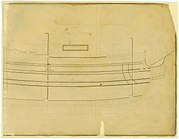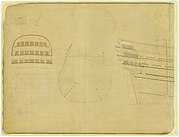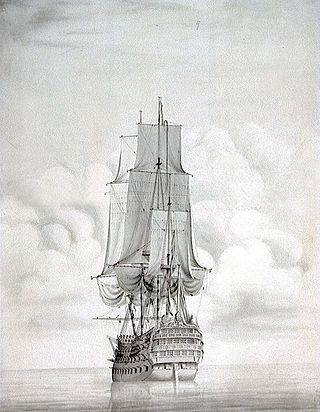
HMS Vanguard was a 90-gun second-rate ship of the line of the Royal Navy, built at Portsmouth Dockyard and launched in 1678.
Five ships of the Royal Navy have been named HMS Princess Royal:
Six ships of the Royal Navy have been named HMS Prince, including:
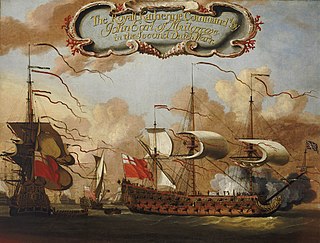
HMS Royal Katherine was an 84-gun full-rigged second-rate ship of the line of the Royal Navy, launched in 1664 at Woolwich Dockyard. Her launching was conducted by Charles II and attended by Samuel Pepys. Royal Katherine fought in both the Second and Third Anglo-Dutch Wars and afterwards, the War of the Grand Alliance before entering the dockyard at Portsmouth for rebuilding in 1702. In this rebuilding, she was upgraded to carry more guns, 90 in total, and served in the War of the Spanish Succession during which she was renamed Ramillies in honour of John Churchill's victory at the Battle of Ramillies. She was rebuilt again in 1742–3 before serving as the flagship of the ill-fated Admiral John Byng in the Seven Years' War. Ramillies was wrecked at Bolt Tail near Hope Cove on 15 February 1760.

HMS Royal Oak was a 74-gun third-rate ship of the line of the Royal Navy, built by Jonas Shish at Deptford and launched in 1674. She was one of only three Royal Navy ships to be equipped with the Rupertinoe naval gun. Life aboard her when cruising in the Mediterranean Sea in 1679 is described in the diary of Henry Teonge.
Three ships of the Royal Navy have borne the name HMS Ossory, after the Kingdom of Ossory, in Ireland, or possibly Thomas Butler, Earl of Ossory:

HMS Duke was a 90-gun second-rate ship of the line of the Royal Navy, launched on 13 June 1682 at Woolwich Dockyard.

HMS Royal Charles was a 100-gun first-rate ship of the line of the Royal Navy, designed and built by Sir Anthony Deane at Portsmouth Dockyard, where she was launched and completed by his successor as Master Shipwright, Daniel Furzer, in March 1673. She was one of only three Royal Navy ships to be equipped with the Rupertinoe naval gun.

HMS Britannia was a 100-gun first rate ship of the line of the Royal Navy, built by Phineas Pett II at Chatham Dockyard, and launched on 27 June 1682.

HMS Falkland was a 50-gun fourth-rate ship of the line of the Royal Navy, built by Holland of New Castle, New Hampshire, and purchased by the navy in 1696.

The Prince Royal was a 55-gun royal ship of the English Royal Navy. It was later rebuilt and renamed HMS Resolution.

President was a 38-gun fourth rate frigate of the Royal Navy, originally built for the navy of the Commonwealth of England by Peter Pett I at Deptford Dockyard, and launched in 1650.
HMS Duchess was a 90-gun second rate ship of the line of the Royal Navy, built by John Shish at Deptford Dockyard, and launched in May 1679.
HMS Albemarle was a 90-gun second rate ship of the line of the Royal Navy, launched on 29 October 1680 at Harwich.
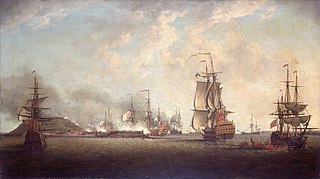
HMS Neptune was a 90-gun second-rate ship of the line of the Royal Navy. She was built under the 1677 "Thirty Great Ships" Programme and launched in 1683 at Deptford Dockyard.
HMS Ranelagh was a three-decker 80-gun third-rate ship of the line of the Royal Navy, launched at Deptford Dockyard on 25 June 1697. She took part in a number of actions during the War of the Spanish Succession, including the Battle of Vigo in 1702 and the Battle of Vélez-Málaga in 1704.
HMS Triumph was a 90-gun second rate ship of the line of the Royal Navy, launched at Chatham Dockyard on 2 March 1697. She was renamed HMS Prince in 1714.
HMS Norwich was a 50-gun fourth rate ship of the line of the Royal Navy, launched at Deptford on 24 August 1693.

HMS Mary was a 60-gun fourth rate ship of the line of the Royal Navy, built at Chatham Dockyard and launched on 12 May 1704.
Seven ships of the Royal Navy have been named HMS Princess, HMS Princesse or HMS Princessa:
